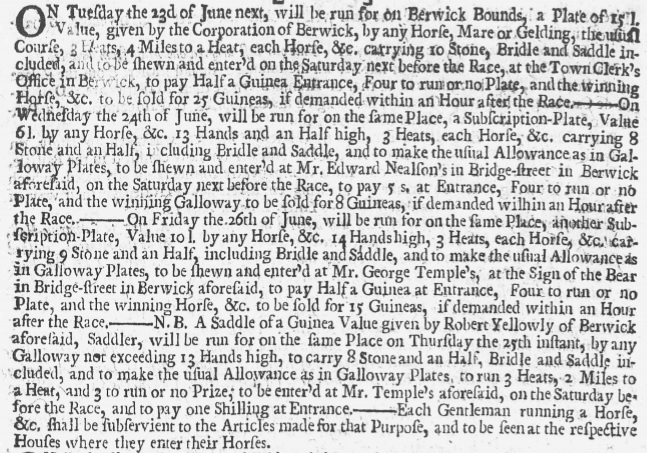Earliest meeting: March 1639
Final meeting: Wednesday 2nd April 1862
The Northumbrian town of Berwick-upon-Tweed is the most northerly town in England being less than 3 miles from the Scottish border. Although it is in England, it is included in this volume because much of the racing in the vicinity of the town was at Lamberton in Scotland. Berwick began as an Anglo-Saxon settlement, its name meaning ‘barley village’. The earliest reference to racing in the town was in a letter written by Henry, Lord Clifford in March 1639 refusing permission for a horse race match to take place for fear it would create unrest. Again in 1654 racing was planned, but Cromwell sent a number of troops to ensure the meeting did not take place. The first hard evidence of a meeting taking place was in April 1684 when three races were contested for the Berwick £20 Town Plate, the £30 Town Plate and the Smaller Town Plate. A condition of entry was that horses had to be stabled in Berwick fourteen days prior to the races. In the late 17th century Berwick was divided into the Westgait area and the Royal Burgh of North Berwick consisting of Eastgait and Trongait. A separate horse race meeting became established in North Berwick in 1695. The races were sponsored by the local Laird Sir Hew Dalrymple, along with the Town Council, taking place annually on the first Monday of January, known as Hansel Monday. The course was on the sands west of the Eil burn, offering spectators a splendid view from the top of the dunes.
I am grateful to Jim Herbert of the Berwick Time Lines for providing the extract shown below from the Newcastle Courant of Saturday 16th May 1724. It shows that a meeting did take place on Tuesday 23rd June 1724.

Berwickshire Steeplechase, Berwick Purse of Gold, Berwick Town Plate
April 1686
Berwick Town Plate for £20
Berwick Town Plate for £30
Berwick Smaller Town Plate
Thursday 2nd May 1861
Berwick Harriers Hunt Cup
1. Cahirmee, bay gelding owned by Mr T Calder
2. Brunette, bay mare owned by Captain G Suttie
3. King Arthur, aged horse owned by Mr R Calder
The final meeting, organised by the Berwickshire Hunt Committee, took place at Harcase Farm , near Duns, on Wednesday 2nd April 1862.
Much of the information about this course has been found using internet research and is in the public domain. However, useful research sources have been:-
London Illustrated News
Racing Illustrated 1895-1899
The Sporting & Dramatic Illustrated
Northern Turf History Volumes 1-4 by J.Fairfax-Blakeborough
The Sporting Magazine
A Long Time Gone by Chris Pitt first published in 1996 ISBN 0 900599 89 8
Racing Calendars which were first published in 1727



